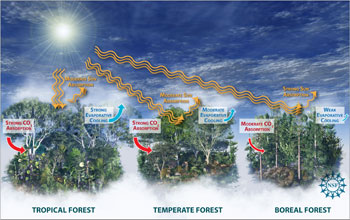Multimedia Gallery
Global Forests and Climate Change (Image 2)
Forests play an integral role in the Earth's climate, and each forest type--tropical, temperate and boreal--has varying impacts on the climate, serving to both cool and warm the Earth. Forests help reduce global warming by absorbing the greenhouse gas carbon dioxide through photosynthesis and cooling the atmosphere through evaporation and transpiration. However, some forests, such as boreal forests in the northern latitudes, can be darker than their surrounding terrain and absorb the sun's energy more readily, which can lead to increasing warming. The play between these competing influences is currently an area that scientists are intensely studying.
This image accompanied NSF press release, "If a Tree Falls in the Forest, and No One Is Around to Hear It, Does Climate Change?" [Image 2 of 3 related images. See Image 3.]
Credit: Nicolle Rager Fuller, National Science Foundation
Images and other media in the National Science Foundation Multimedia Gallery are available for use in print and electronic material by NSF employees, members of the media, university staff, teachers and the general public. All media in the gallery are intended for personal, educational and nonprofit/non-commercial use only.
Images credited to the National Science Foundation, a federal agency, are in the public domain. The images were created by employees of the United States Government as part of their official duties or prepared by contractors as "works for hire" for NSF. You may freely use NSF-credited images and, at your discretion, credit NSF with a "Courtesy: National Science Foundation" notation.
Additional information about general usage can be found in Conditions.
Also Available:
Download the high-resolution JPG version of the image. (879 KB)
Use your mouse to right-click (Mac users may need to Ctrl-click) the link above and choose the option that will save the file or target to your computer.



